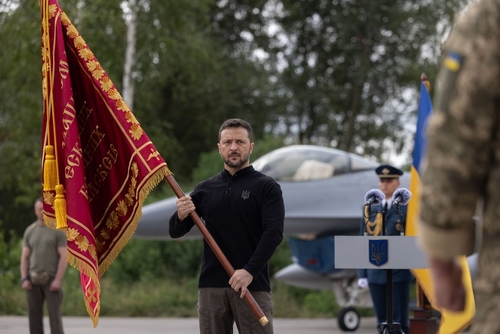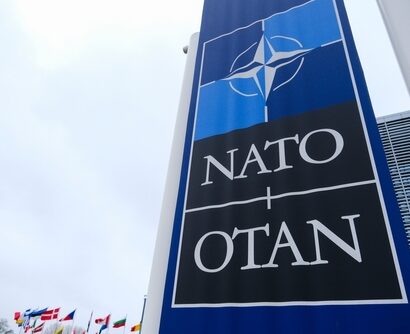Abstract: The strategic use of decoys has become critical to Ukraine’s defence strategy in its war with Russia. Ukraine effectively misleads Russian forces by deploying decoys that mimic the visual, thermal, and radar signatures of real military assets, compelling them to expend valuable resources on false targets. This analysis explores how these deception tactics, bolstered by technological advancements, have helped Ukraine preserve its resources and amplify the psychological impact on its adversary. Drawing on examples such as Russia’s exaggerated claims of destroying more HIMARS than were actually delivered, this analysis highlights the continued relevance of deception in modern warfare.
Problem statement: How can decoys in modern warfare help outnumbered forces protect assets and preserve resources?
So what?: Decoy strategies should be further developed and employed by defence planners to mislead adversaries, conserve resources, and protect high-value targets.

Source: shutterstock.com/photowalking
Historical Context of Military Deception
Military deception has long been a cornerstone of strategy—from ancient times to contemporary conflicts. Sun Tzu famously stated, “All warfare is based on deception”.[1] This principle reflects a long-standing tradition of using deception to gain strategic advantages. This practice has evolved and persisted into modern tactics, where smaller or outnumbered forces deceive stronger adversaries to level the playing field.
![Example of a Ghost Army tank decoy.[2]](https://tdhj.org/wp-content/plugins/wp-fastest-cache-premium/pro/images/blank.gif)
Example of a Ghost Army tank decoy.[2]
As part of the broader Operation Bodyguard, Fortitude used inflatable tanks, fake radio traffic, and misleading intelligence to convince the Germans that an invasion of France would occur at Pas-de-Calais.
![Illustration related to Operation Fortitude.[6]](https://tdhj.org/wp-content/plugins/wp-fastest-cache-premium/pro/images/blank.gif)
Illustration related to Operation Fortitude.[6]
The Technology Behind Modern Decoys
Technological advancements have transformed the role and sophistication of decoys. While earlier decoys were relatively simple due to the limited capabilities of enemy reconnaissance—like inflatable tanks used in the Second World War—modern decoys have evolved to deceive even advanced surveillance systems.[10] Modern decoys are designed not only to mimic actual weapon systems visually but also to replicate their thermal, radar, and electronic signatures, making them indistinguishable from the real thing under high-tech reconnaissance.
Technological advancements have transformed the role and sophistication of decoys.
![Inflatable HIMARS decoy used in the war in Ukraine.[11]](https://tdhj.org/wp-content/plugins/wp-fastest-cache-premium/pro/images/blank.gif)
Inflatable HIMARS decoy used in the war in Ukraine.[11]
![Two Howitzer systems compared: a real one and a mock-up.[12], [13]](https://tdhj.org/wp-content/plugins/wp-fastest-cache-premium/pro/images/blank.gif)
Two Howitzer systems compared: a real one and a mock-up.[12], [13]
![Spinning antenna deception[14]](https://tdhj.org/wp-content/plugins/wp-fastest-cache-premium/pro/images/blank.gif)
Spinning antenna deception[14]
![Thermal imaging deception[15]](https://tdhj.org/wp-content/plugins/wp-fastest-cache-premium/pro/images/blank.gif)
Thermal imaging deception[15]
![Electromagnetic emission deception[16]](https://tdhj.org/wp-content/plugins/wp-fastest-cache-premium/pro/images/blank.gif)
Electromagnetic emission deception[16]
Nevertheless, one limitation remains: decoys often lack the environmental impact, such as track marks left by real systems. To address this, decoys should be placed where real equipment was previously deployed to use existing footprints or in areas that mimic real military positions. They are often covered with camouflage to stay hidden from direct observation while still attracting enemy fire. The strategic placement of decoys is thus as important as their physical accuracy, making them even more convincing and effective in deceiving the enemy.
![Decoy covered with camouflage.[19]](https://tdhj.org/wp-content/plugins/wp-fastest-cache-premium/pro/images/blank.gif)
Decoy covered with camouflage.[19]
![Deceiving with track marks left by real systems.[20]](https://tdhj.org/wp-content/plugins/wp-fastest-cache-premium/pro/images/blank.gif)
Deceiving with track marks left by real systems.[20]
Psychological and Operational Benefits of Decoys
In warfare, the psychological impact of deception is as important as its operational effects. Decoys have the potential to sow confusion, create uncertainty, and distort enemy decision-making processes. In Ukraine, Ukrainian forces have been using decoys to complicate Russian efforts to assess the real strength and positioning of Ukrainian forces. In some cases, Russian forces have struggled to differentiate between real and fake targets, sometimes forcing them to question the reliability of their intelligence.[21]
Russian forces have struggled to differentiate between real and fake targets, sometimes forcing them to question the reliability of their intelligence.
One of the significant psychological impacts of this strategy is that it forces Russian forces to overestimate Ukraine’s capabilities. When Russian troops encounter what seems like a significant build-up of Ukrainian assets, they may assume they are facing a much larger force than in reality.[22] This misperception diverts Russian resources and attention away from genuine threats, stretching their logistical capabilities.
A compelling example of this kind of military deception occurred during the surprise Ukrainian counteroffensive in Kharkiv in September 2023. A key factor in Ukraine’s success was its adept and calculated use of deception, through which the Ukrainians cleverly misled Russian forces. They deliberately signalled through various channels, including information operations, that a major counteroffensive was imminent in Kherson. This message was reiterated with such confidence that it convinced Russian commanders that the primary objective would be Kherson. As a result, Russian forces were redeployed from the Kharkiv region to defend against the anticipated attack in Kherson. This deception effectively manipulated Russian perceptions of Ukraine’s military capabilities, diverting critical resources and attention away from the actual point of attack.[23]
Over time, the continued waste of valuable precision-guided munitions and drones on decoys can lead to growing frustration and demoralisation within Russian ranks. While media discussions on Russian morale tend to focus more on the severe losses suffered in high-casualty operations, the psychological impact of discovering that high-value munitions were expended on low-cost, inflatable or plywood decoys cannot be dismissed. The realisation that expensive, sophisticated systems were deployed against targets worth a fraction of their cost could have an impact on military leaders and troops alike, further eroding their morale.
By using decoys, Ukraine can create an atmosphere of uncertainty that forces Russian forces to misallocate resources, leading to operational inefficiencies. While direct evidence linking decoys to the weakening of Russian resolve is limited, their consistent impact on Russia’s logistical and strategic adjustments adds to the broader challenges Russian forces face. These operational missteps, induced by wasting munitions on fake targets, contribute to an overall erosion of confidence and potentially undermine Russian effectiveness over time.[24] Overall, through the use of decoys, Ukraine not only protects assets but also enhances psychological warfare, turning it into a force multiplier that permeates both the mental and physical aspects of the battlefield.[25]
Operational Benefits
At a basic level, decoys create the illusion of larger forces or mislead the enemy about asset locations, confusing adversaries and safeguarding valuable resources by diverting enemy fire from actual targets.[26] Beyond simple protection, decoys can manipulate enemy forces into disadvantageous positions or expose them to counter-attacks, such as luring them into revealing their locations for counter-battery fire. For instance, Ukrainian forces used mannequins during the initial phases of the Battle of Kharkiv to deceive advancing Russian forces. These mannequins, procured from commercial establishments and positioned to simulate Ukrainian defensive lines, successfully confused the Russian troops, leading them not only to waste munitions but also to expose their artillery positions, providing Ukrainian forces with tactical advantages.[27]
Beyond simple protection, decoys can manipulate enemy forces into disadvantageous positions or expose them to counter-attacks.
The effectiveness of decoys depends on their ability to withstand detection. Their success often hinges on time, distance, and secondary indicators such as thermal signatures and placement context, all of which enhance the decoy’s credibility. Using decoys primarily manipulates the enemy’s decision-making, forcing them into poor decisions, such as wasting resources or falling into traps. Effective deception narrows the adversary’s options, increasing uncertainty and clouding their judgment. The element of surprise is key, limiting the enemy’s ability to assess their choices and pushing them toward suboptimal actions fully.
Successful deception requires careful planning to mislead the enemy, obscuring true intentions and guiding them into decisions that align with strategic goals. This convinces the enemy that their actions are more or less successful than they actually are, ultimately benefiting the deceiver.
Enduring Strategic Value
The Ukraine conflict vividly demonstrates the enduring strategic value of military deception, particularly through the innovative use of decoys. As Ukrainian forces have shown, decoys can effectively protect assets, mislead adversaries and impose significant psychological and economic costs, even against a superior opponent. This approach reaffirms that, despite advances in warfare technology, the art of deception remains a critical component of military strategy, capable of shaping battlefield outcomes and preserving vital resources. The lessons from Ukraine reaffirm the enduring relevance of ancient military wisdom in contemporary warfare, highlighting deception’s timeless role as a force multiplier in modern conflict.
Nicola Bonsegna is a student with research interests in defence technologies, military strategies, and cybersecurity. He has published articles on the strategic integration of unmanned systems and defence innovation. His academic background focuses on international security and defence studies. The views contained in this article are the author’s alone and do not represent the views of the University of Trento.
[1] Sun Tzu, The Art of War, trans. Lionel Giles (London: Luzac & Co., 1910), https://classics.mit.edu/Tzu/artwar.html.
[2] B. Mello, “Ghost Army Exhibit Opens at the Nevada Museum of Art,” in: This Is Reno, March 16, 2023, https://thisisreno.com/2023/03/ghost-army-exhibit-opens-at-the-nevada-museum-of-art/.
[3] Australian War Memorial, First World War Official Histories: Volume I – The Story of ANZAC: the first phase, [C4220], https://www.awm.gov.au/collection/C4220.
[4] Operation Fortitude, in: Encyclopaedia Britannica, https://www.britannica.com/event/Operation-Fortitude.
[5] D-Day’s Parachuting Dummies and Inflatable Tanks, in Imperial War Museums, https://www.iwm.org.uk/history/d-days-parachuting-dummies-and-inflatable-tanks.
[6] Operation Fortitude, in: Alchetron, [2024], https://alchetron.com/Operation-Fortitude.
[7] Edin Hardaus, “Tito’s Top Secret Underground Airbase Zeljava You Never Knew Existed,” in: War History Online, September 02, 2015, https://www.warhistoryonline.com/war-articles/titos-top-secret-underground-airbase-zeljava-you-never-knew-existed.html.
[8] Yongsheng Kang, “Information Warfare Prompts a Camouflage Revolution,” China Youth Daily, August 10, 2012, http://zqb.cyol.com/html/2012-08/10/nw.D110000zgqnb_20120810_2-09.htm.
[9] “The Art of Deception: Decoys in Modern Warfare,” in: The Business Standard, https://www.tbsnews.net/thoughts/art-deception-decoys-modern-warfare-899236.
[10] “Ukrainian Forces Use Decoys to Evade and Deceive Russian Military,” in: Kyiv Post, https://www.kyivpost.com/post/21544.
[11] “Czech Inflatable Weapon Decoys a Hit as Ukraine War Rages,” in: RFI, March 06, 2023, https://www.rfi.fr/en/business-and-tech/20230306-czech-inflatable-weapon-decoys-a-hit-as-ukraine-war-rages.
[12] “MM Gun Howitzer D-30 at Military Historical Museum St. Petersburg Russia,” in: Dreamstime, https://www.dreamstime.com/editorial-stock-photo-mm-gun-howitzer-d-military-historical-museum-st-petersburg-russia-april-artillery-engineers-signal-corps-image87480803.
[13] “One Year of Drones in the Full-Scale War: Ukraine’s Experience and Challenges,” in: Ukrainska Pravda, March 11, 2024, https://www.pravda.com.ua/eng/articles/2024/03/11/7445807/.
[14] Not What You Think, “These are Tanks that Ukraine hopes Russia Would Destroy,” in: Youtube, May 10 2024, https://www.youtube.com/watch?v=07OkVy5B8no.
[15] Idem.
[16] “Battlefield Decoys and Deception Reaffirmed in Ukraine,” in: Armada International, September 06, 2023, https://www.armadainternational.com/2023/09/battlefield-decoys-and-deception-reaffirmed-in-ukraine/.
[17] “Ukrainian Forces Use Decoys to Pinpoint Russian Artillery Fire – Report by The Wall Street Journal on Model Production by Metinvest for Ukrainian Armed Forces,” in: Metinvest, October 13, 2024, https://metinvestholding.com/en/media/news/zsu-vikoristovuyutj-maketi-schob-tochno-viznachiti-zvdki-strlya-rosjsjka-artilerya-reportazh-the-wall-street-journal-z-virobnictva-modelej-tehnki-vd-metnvestu-dlya-zsu.
[18] Ashish Dangwal, “44 HIMARS? Russia Faces Online Mockery for ‘Destroying’ More US MLRS Than Delivered to Ukraine,” in: Eurasian Times, September 03, 2022, https://www.eurasiantimes.com/44-himars-russia-faces-online-mockery-for-destroy-us-mlrs/.
[19] Melissa Bell, Daria Tarasova, and Pierre Bairin, “True to Life but Without the Price Tag: The Decoy Weapons Ukraine Wants Russia to Destroy,” CNN, September 11, 2023, https://edition.cnn.com/2023/09/11/world/ukraine-russia-decoy-weapons-intl/index.html.
[20] Not What You Think, “These are Tanks that Ukraine hopes Russia Would Destroy,” in: Youtube, May 10 2024, https://www.youtube.com/watch?v=07OkVy5B8no.
[21] Jorge L. Rivero, “Decoy Warfare: Lessons and Implications from the War in Ukraine,” Proceedings, April 2024, U.S. Naval Institute, https://www.usni.org/magazines/proceedings/2024/april/decoy-warfare-lessons-and-implication-war-ukraine.
[22] Idem.
[23] Bredow, Douglas A. “The Kherson Ruse: Ukraine and the Art of Military Deception,” Modern War Institute, August 08, 2023, https://mwi.westpoint.edu/the-kherson-ruse-ukraine-and-the-art-of-military-deception/.
[24] Delamer, Chris. “’Decoy Arms Race’ Playing Out in Ukraine, Harder to Fake Tanks, Weapons,” Business Insider, October 07, 2023, https://www.businessinsider.com/decoy-arms-race-playing-out-ukraine-harder-fake-tanks-weapons-2023-10.
[25] Miller, Stephen W. “Battlefield Decoys and Deception: Reaffirmed in Ukraine,” Armada International, September 20, 2023, www.armadainternational.com/2023/09/battlefield-decoys-and-deception-reaffirmed-in-ukraine/.
[26] Naval Postgraduate School, “Innovation in Combat: Decoys & Deception in Russo-Ukrainian Conflict – Seapower Conversation,” Youtube, November 21 2023, https://www.youtube.com/watch?v=pgbhhBw-jNE.
[27] Rivero, Jorge L. “Decoy Warfare: Lessons and Implications from the War in Ukraine,” Proceedings, April 2024, U.S. Naval Institute, https://www.usni.org/magazines/proceedings/2024/april/decoy-warfare-lessons-and-implication-war-ukraine.





